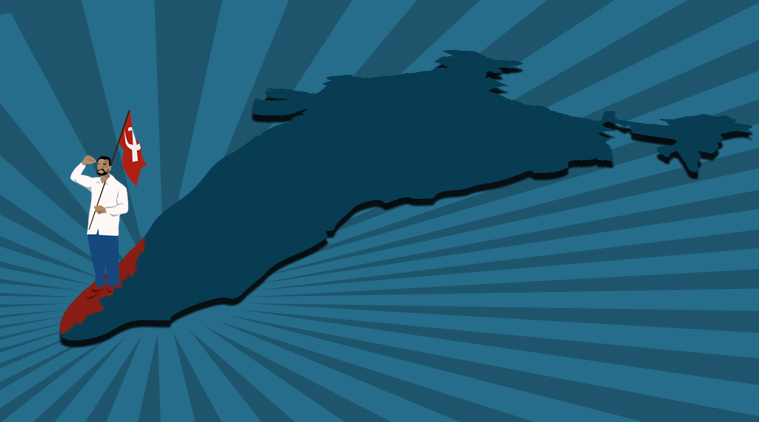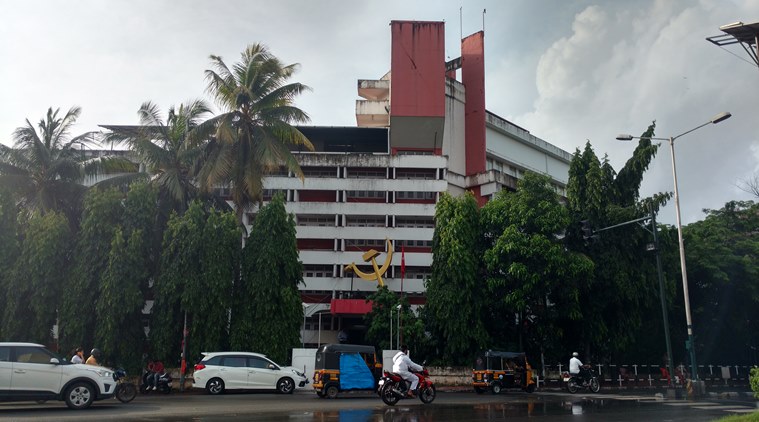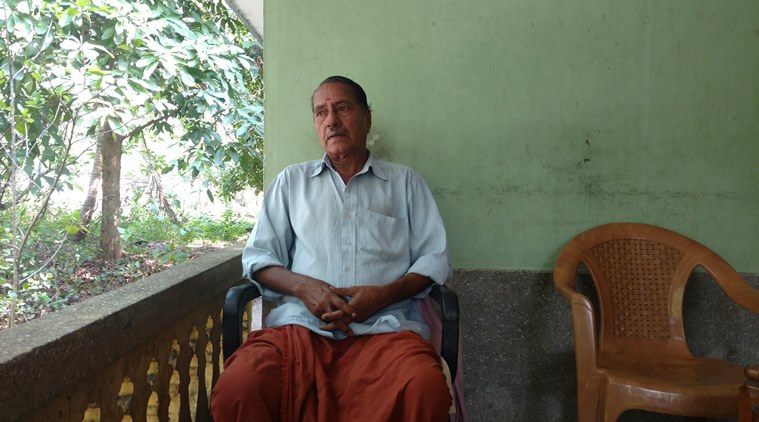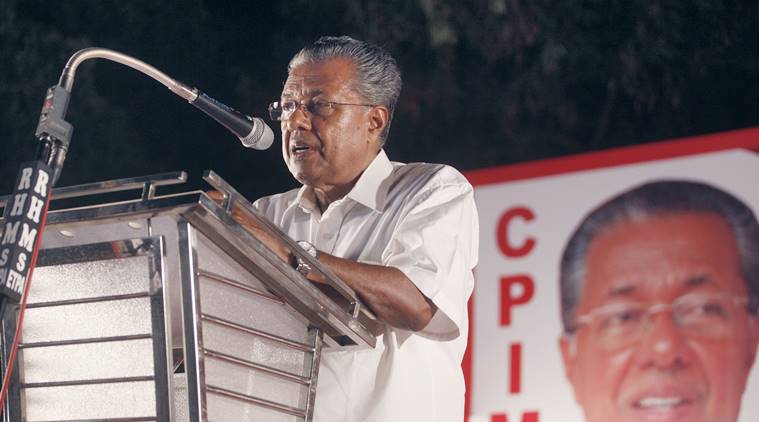From main opposition party to Communist Party of Kerala: Left’s hopes now hinge on keeping the Right away
Shortly after the CPM’s Tripura rout, IndianExpress.com travels to the ground in Kerala, which holds the last vestige of democratically-elected Communist power in India, to check if its roots are still intact.

After defeats in Assembly elections in Tripura and West Bengal, Kerala remains the only state in the country to have a democratically-elected Communist government. (Credit: Vishnu PP)
Agartala is nearly 4,000 km away from Thiruvananthapuram, the capital of Kerala. Events, political or otherwise, in the northeastern state rarely make any noise here in the south. But earlier this year, on March 3 to be precise, as the BJP seeped its way into Tripura, a Left citadel for a quarter of a century, strong aftershocks were felt here on the southwestern coast. When counting of votes in the Assembly elections ended that day, it became clear that Tripura had fallen out of the Communist grip too, seven years after West Bengal was lost in a similar fashion. Shortly after the CPM’s Tripura rout, IndianExpress.com travels to the ground in Kerala, which holds the last vestige of democratically-elected Communist power in India, to check if its roots are still intact.
It’s a scorching April afternoon. Amal Raj, a student of B.A. Malayalam, and his college friend sat in the shade of an imposing memorial erected to honour the deaths of five activists of the Democratic Youth Federation of India (DYFI) in a police firing in November, 1994. The memorial and the tragic 1994 incident occupies an important position in the Communist antecedents in the state and is often held up by the Left as a symbol of youth struggle against the establishment. Kuthuparamba, where the memorial stands, happens to be located in the heart of Kannur district which Communist leaders like to brag, is the ‘jeeva-vayu’ (life and air) of the party.
In a state where student activism forms the bedrock of active politics and leaves breadcrumbs for many politicians to later emerge into legislators and parliamentarians, Raj is fiercely opinionated about why he chose the SFI, the student wing of the CPI(M), in college.
“Nammude naadinu vendathu communism aanu ennu thonni (I felt that Communism is the ideology that our state needs). But having said that, communism is essentially a way of thinking. There are limits to its practicality in everyday life,” he explains.
Just then, his friend, who happens to lead the ABVP (student wing of the RSS) unit in his college, joins in. Raj, smiling, adds, “There’s no politics in friendship. Anyone can come here and sit. We come here often after college in evenings, chat for hours and then leave for our respective homes.”
“In Tripura, you must have seen how the BJP destroyed the statues of Lenin. It shows their intolerance. But here in Kerala, we have space for everyone, the Left, the Centre and the Right,” Raj says.
It’s true. Since its formation in 1956, Kerala has imbibed political ideologies of all hues and colours, from the communists to the socialists, the centre-left Congress to the right-wing BJP and RSS. But for right-wing forces, it has never been successful in influencing the electorate to vote for it, despite having a robust organisational network. Until 2016, BJP couldn’t get a single candidate elected to the state’s legislature, but its ideological parent, the RSS, runs the largest number of shakhas in the country in Kerala. Thus, the state’s voters chose to play musical chairs of sorts, alternating every five years between the CPM-led Left Democratic Front (LDF) and the Congress-led United Democratic Front (UDF). Smaller parties like the Indian Union Muslim League (IUML) and the Kerala Congress (Mani), which wield hegemonic influence over Muslim and Christian demographics respectively, tend to corner the remaining seats to help either coalition form a majority and play kingmaker.
The existential crisis of right-wing politics has been its difficulty in harvesting results in a place considered unconducive for its ideology. Post 2014, with the arrival of Narendra Modi-Amit Shah combination on the national stage, there has, however, been an attempt by the saffron party to assert itself by allying with caste-based parties aimed at unifying the desperate Hindu communities into a single voting block. In some regions, this assertiveness has found results when the party’s vote-share jumped by as much as five times in the 2016 Assembly elections. With the Congress cornering a major share of the minority vote, it’s the fight to stake claim over the Hindu vote that intensifies the rivalry between the BJP and the Left parties.
In interviews, grassroot leaders of the CPM say they face no imminent electoral threat from the BJP in the state. To a large extent, their reasons are valid. In West Bengal, after 34 years of Communist rule, the party’s cadre was frustrated with the rigid leadership and after incidents like Nandigram thought it fit to shift loyalties to the Trinamool which offered hope and change. This worker shift weakened the party terribly, eroding its base.
But here in Kerala, where the Communist movement emerged on the back of peasant struggles and coir and beedi worker agitations in the 1940s and 1950s, the worker base is still strong and largely unmoved. The floating middle-class vote base adds to their electoral coffers.
Secondly, the religious demographics of Kerala, with minorities accounting for half the population, makes the soil naturally infertile for the right-wing. Thirdly, for the Left in Tripura and Bengal, decades of anti-incumbency did the party in. However, here, with voters opting for a new government every five years, the voter antipathy to the Left swings like a pendulum.
Narrative of ‘where Congress sets, BJP rises’
“In Tripura, it was the Congress’ vote-share that plummeted from 36% to less than 2%. Our vote-share has not shown a steep decline. So they (BJP) advanced at the cost of the Congress,” said Madhu, CPM area secretary in-charge of Payyanur in Kannur district. “They are two sides of the same coin and they follow the same bourgeois policies.”
The narrative that a weakening and faction-ridden Congress is giving space for the BJP to grow is the predominant narrative that the CPM has been selling in Kerala especially after it saw its humiliating debacle in Tripura. Wooing the minorities, especially Muslims, with this ideology will be the party’s strategy, indicated a source.
Similarly, the victory of lone BJP MLA and party warhorse O Rajagopal in Nemom is one that Left leaders cherish to quote every time they are asked about the BJP’s growth in the state.
Anurag, a young SFI area secretary in charge of Koothuparambu, asks, “What happened in Nemom? Rajagopal won because of the flow of votes from the Congress to the BJP there. Our base is still intact.”
A closer scrutiny of the macro-data of the 2016 Kerala Assembly elections strengthens the CPM’s argument. Even though the BJP bagged just one seat, it came second in as many as seven seats and its vote-share surged by as much as five times in over 25 seats in 2016. In a majority of these seats, the LDF candidate was seen to be the eventual winner, benefiting immensely from a split of the pro-Congress votes and a 2%-3% swing of the ‘floating’ voter base towards the BJP. In districts like Kollam, Thrissur and Palakkad, where the Left already had a good support-base, it was able to win maximum of the seats here as the BJP made inroads into the traditional Congress vote-bank.
“BJP’s rise in Kerala can only happen with the help of Congress because the latter only looks at short-term gains. Wherever Congress sets, BJP rises,” says V N Gopalakrishnan, a long-time CPM member and two-time panchayat president in Vayalar in Alappuzha district.
But at the same time, it doesn’t mean the state’s electoral map is all black and white. The Left’s principal dilemma in Kerala has been that its core voter base – the lower and lower-middle class Hindu communities – are being assiduously wooed by the saffron party. The Muslims have never been a big fan of the Communists and excluding isolated voting in certain regions, they have generally tended to align with the Congress or the IUML. Which explains why the LDF is desperate to bring the KC(M), which sits on a huge Christian vote base in central Kerala, into its fold.
“If Mani is ready to change his stance vis-a-vis corruption, we are ready to work with him,” a party leader indicates.
‘LDF benefits from a three-way race’
In the last 35 years in Kerala, no government, either of the Congress or the Left, has returned to power. Political commentators and analysts say the CPM, under the leadership of chief minister Pinarayi Vijayan, is now working overtime to buck the trend in 2021 by making the race to the state Assembly a three-cornered one through which it hopes to ride to power once again on a split of anti-incumbency votes. What used to be a traditional two-way fight is being positioned as having the potential for a three-cornered one.
“I think he (Vijayan) very well harbours a dream to come back to power after five years because that would break a record. But for that, he needs to split the Opposition votes. And the best way to do that is by ensuring a stream of votes to flow towards the BJP. If you have noticed, he has a soft approach towards the BJP/RSS,” says MM Somasekharan, a former central executive member of the CPI(ML).
In fact, political watchers say that by drawing a parallel between the rise of the BJP and the nationwide decline of the Congress, the CPM hopes to project itself as the ‘ideal choice’ for voters in Kerala, especially the minorities. That explains the CPM’s bid to organise a statewide yatra right after the BJP held a similar yatra against political killings.
“The CPM is trying to pit itself against the BJP so that it can win in a triangular contest. The BJP can only advance by depleting the Congress which is not entirely possible because in Kerala, the latter is not that organisationally weak. So in a way, the stronger the BJP gets, the better is for the CPM,” remarks G Pramod Kumar, a former journalist who has written extensively about Left politics in Kerala.
The recent bye-election result is a Chengannur is a case in point. While the Congress chose to maintain the election as a straight LDF versus UDF fight, the CPM overtly brought the BJP into the equation especially as the saffron party had quite a bit of a base there. In doing so, it not only gave the BJP indirect visibility but also pointed the mirror towards the minorities. The result: CPM won the bye-election by a record 20,000 votes – the highest margin in the constituency.
Kodiyeri Balakrishnan, the CPM’s top organisational leader, says as much that his party acknowledged the BJP’s strength in Chengannur. “In the previous election in 2016, we saw the BJP with the support of the BDJS mobilising their strength and making an attempt to win the seat. So, we were working knowing that the BJP has a base in Chengannur. We thought the party would make some gains, but they have been unable to make any gains. It has been a setback for them,” he tells in an exclusive interview. (Full interview later this week)
It is clear that for the CPM, anything less than a 15-seat haul out of 20 in the upcoming Lok Sabha elections could wreak severe heartburn among the cadre and inflict opprobrium to the image of its government. With Bengal and Tripura units unlikely to deliver a large share of seats, the Kerala unit of the party mockingly described now as Communist Party of Kerala (Marxist), will have to step up and deliver for its national leadership. In short, much hinges for the party in 2019 if it hopes to come back to power in 2021.
(Tomorrow: Has CPM undergone a tectonic shift in its policy-making to solely win elections? Former party members speak out.)
For all the latest India News, download Indian Express App
© IE Online Media Services Pvt Ltd
 In interviews, grassroot leaders of the CPM say they face no imminent electoral threat from the BJP in the state.
In interviews, grassroot leaders of the CPM say they face no imminent electoral threat from the BJP in the state. Gopalakrishnan is considered a party ideologue in Vayalar, a place that saw the earliest worker uprisings in Kerala propelled by the Communists.
Gopalakrishnan is considered a party ideologue in Vayalar, a place that saw the earliest worker uprisings in Kerala propelled by the Communists. Kerala chief minister Pinarayi Vijayan has also been the CPM’s longest state secretary, holding the post for 17 years. (Express archive photo)
Kerala chief minister Pinarayi Vijayan has also been the CPM’s longest state secretary, holding the post for 17 years. (Express archive photo)





































No hay comentarios:
Publicar un comentario